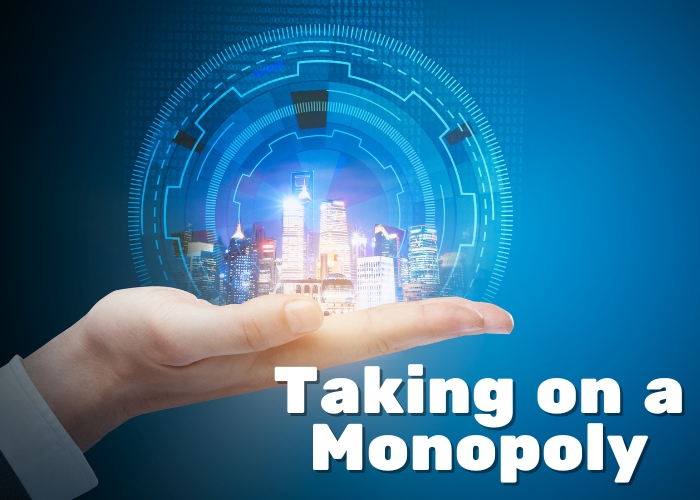Four of the most costly corporations in the world are monopolies in the technology sector. In contrast to Aramco, these businesses have monopolised the accumulation of technological ideas, which is why they have grown so pricey. Technology monopolies are the source of success for numerous companies, including Apple, Tesla, Toshiba, Alphabet, Amazon, Facebook, and Microsoft. According to WSJ research, intangible assets make up more than 80% of the $25 trillion in total assets held by S&P 500 corporations as of 2018. But how could businesses achieve monopolistic market dominance by accumulating IP assets?
Why does the number of rival companies keep declining even if the market is expanding? For instance, there were just six manufacturers of hard drives in 2009 compared to 85 in 1984. Similarly, Microsoft Word emerged victorious from the 1980s word processor manufacturers’ competitive war. Six companies remain fighting for 3D NAND flash memory in 2022, down from over twenty in the 1990s. However, what are the factors that lead to technology monopolies succeeding? Does acquiring the market dominance necessary to become a technology monopoly happen suddenly, or is there a systematic pattern?
Technology can significantly affect monopolies in several ways, both by strengthening and undermining them. Here’s how to do it:
Increasing the Economies of Scale in a Monopoly:
Cost Advantage: A monopolistic business can outperform possible rivals by using advanced technologies to lower manufacturing costs.
Entry Barriers: A monopoly’s substantial early technological investment might erect formidable obstacles in the way of potential competitors.
R&D and innovation:
Continuous Improvement: To keep ahead of the competition, monopolies with significant financial resources might continuously make substantial R&D investments to improve their goods and services.
Patents and Intellectual Property: New patents and intellectual property can be created due to technological developments, strengthening a monopoly’s hold on the market.
Effects of Networks:
User Base: Technologies that capitalise on network effects, such as software ecosystems or social media platforms, where a service’s value grows with increased usage, can strengthen a monopoly’s position in the market.
Lock-in: Customers need help moving to competitors when they grow reliant on a company’s ecosystem (proprietary hardware, software compatibility, etc.).
Data Management:
Big Data: Monopolies can use enormous volumes of data to target marketing better, streamline operations, and customise services than possible rivals.
Market Insights: Having exclusive access to vast amounts of consumer data gives you insights that you can utilise to improve business plans and proactively counter competitor threats.
Taking on a Monopoly

Innovative Disruption:
New Technologies: By providing better alternatives, emerging technologies have the potential to upend established monopolies. The emergence of digital streaming posed a challenge to established media monopolies.
Agility: Tech-savvy, smaller businesses can develop and adapt fast, bringing new goods and services to the market that challenge the monopoly’s supremacy.
Reduced Entry Barriers:
Digital Platforms: The emergence of digital platforms and online markets lowers the entry barriers for new businesses, allowing smaller ones to reach a worldwide audience more affordably.
Open-Source Technology: Smaller firms can compete without making significant capital investments thanks to the levelling of the playing field provided by open-source software and collaborative technology.
Empowerment of the Consumer:
Information Access: Technology allows customers to obtain more information, which helps them make more educated decisions and choose products other than those monopolists offer.
Social Media and Advocacy: Through organising and advocating against monopolistic practices through social media and other channels, consumers can impact public opinion and regulatory measures.
Regulatory Monitoring:
Technological Enforcement: By detecting and halting monopolistic activities, governments and regulatory agencies can more effectively monitor and enforce antitrust laws through technology.
Global Cooperation: Technology can promote international cooperation, resulting in more efficient regulation of multinational monopolies.
Defining a monopoly in technology
The term “technology monopoly” describes the state of surpassing competitors in the race for innovation by providing products and services of superior quality at lower costs by utilising technological economies of scale, scope, positive externalities, and vertical foreclosure assets. Let’s investigate these underlying causes in more detail:
- Scale: substantial R&D expenses for coming up with concepts that save money on labour, materials, energy, and time; more excellent software implementation of those concepts; and little to no costs associated with reproducing concepts to serve every customer; these technological advancements lead to economies of scale.
- Scope: The transfer of intellectual assets, particularly in software form, between goods creates economies of scope effect out of technology because of their universality and insignificant cost of duplication.
- Positive externalities: as software and connection become more important, these factors fuel ideas for raising the perceived value of products with an expanding user base.
- The creation of a platform from technological possibilities, such as an operating system, search engine, or platform, to power a family of products can be used as an asset in a vertical foreclosure strategy to restrict or refuse access to players upstream and downstream.
Technology monopolies are distinct from traditional ones, which expand due to regulation and collaboration among rent seekers. Instead, a winner-take-all situation emerging from the competition to win the innovation race for providing higher quality at lower cost through a Flow of Ideas leads to a monopoly in technology.
Technological monopoly examples
Microsoft, Apple, Spotify, Google, Amazon, Toshiba, and Facebook are a few prominent examples of technology monopolies. Here are some details regarding smartphone monopolies, the Internet, and personal computers.
- Monopoly on personal computers: Microsoft became the archetypal example of a technological monopoly by implementing a vertical foreclosure strategy around the Windows operating system and incorporating many features into the Office suite. Since there is no cost associated with software copying, Microsoft continues to add features to its Office suite, leaving rival companies with empty purses.
- Smartphone: Apple is the second poster child for the smartphone monopoly. When mobile phones evolved from electronic devices to software-intensive gadgets, Apple started to add a lot of functionality. Additionally, by choosing to use iPhone component plugins obtained through the App Store, it concentrated on generating favourable externality effects.
- Internet monopolies: Recently, technology monopolies have emerged, such as Google and Facebook. Both have used the network externality effects—bigger is better and cheaper—. Moreover, their innovative three-party business model has helped to maximise the network effect.
How to get around monopolies in technology

Technology monopolies arise from the race to develop innovations that keep producing better value at a lower cost, not from collusion and regulations. Therefore, the competition to obtain a monopoly in technology has benefited consumers. However, the winner hesitates to make additional improvements after establishing the monopoly state. In particular, the wave of creative destruction is formed by monopolies’ preference to avoid high-risk reinvention investments. However, this kind of investment is necessary to open up new growth paths continuously. Because of this, society desperately wants to break the monopoly of the mature wave by igniting the next round of creative destruction despite the monopoly race’s positive effects.
As a result, society ought to fund fundamental research and encourage innovation and startups. Additionally, steps should be taken to stop established monopolies from acquiring and suffocating startups riding the reinvention wave.
Act of Balancing
Technology’s overall effect on a monopoly is contingent upon several elements, such as the technology itself, the industry, and the regulatory landscape. Technology can amplify the power of a monopoly, but it also gives competitors the means and chance to innovate and disrupt the market, which could eventually democratise it.

